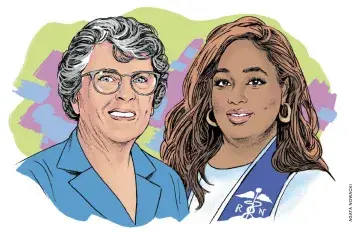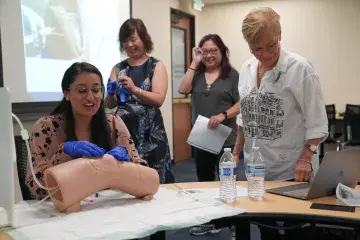When Theresa Cordova Cares for Veterans, She’s Helping Heroes

Nurse Theresa Cordova, BSN ’12, drove to her first in-home patient visit worried that it might reveal a veteran in his late 70s or early 80s living alone, unable to care for himself. In the year before her visit, he’d been in and out of the San Francisco VA Medical Center (SFVA) three times due to congestive heart failure.
When Cordova a retired U.S. Army staff sergeant who served two tours in Iraq, stepped through the doorway to his San Francisco apartment, she was relieved to see it was accessible, clean, and well-kept. Yet the man clearly needed help in other ways. His scores of medications were tossed haphazardly into two boxes—one for those he was currently taking, another for those he was no longer using. In addition, his bathroom lacked grab bars, a bad sign for someone who’d already fallen once in another part of the apartment and had to be rescued by neighbors who heard him yell.
“You learn so much more about how they deal with everyday life by seeing where they live,” Cordova said. “Do they have stairs that pose a fall risk? Can they reach someone if they fall? If they have congestive heart failure, are they weighing themselves every day? Do they need a scale? How can I better educate them about the importance of daily weighing? Also, are they holding onto old medications? Is it confusing? Can I help them organize it to make it easier?”
IMPACT provides targeted care
Cordova is part of the Intensive Management Patient Aligned Care Team (IMPACT) at the SFVA, which she joined in 2020, after working as an in-patient nurse at the SFVA. (Full PPE is required for home visits during COVID.) This interdisciplinary team of nurses, social workers, psychologists, peer support specialists, and physicians works directly with patients. Typically older, many patients served in Vietnam and a few in Korea or World War II, all have cognitive impairment or are being evaluated for it. They often have other complex, chronic conditions too.
The program is marked by an intensive intake process, usually at the veteran’s home, then frequent contact, either in-person or via phone, to manage chronic conditions and more. Since its launch in 2014, the program has aimed to decrease patients’ risk of hospitalization and institutionalization. Nationally, nearly half of the VA’s total healthcare costs come from just 5% of patients, based on a study of a similar program at the Palo Alto VA. It’s a pattern that tracks true for the general public as well. At the SFVA, the program saves the hospital about $3.5 million a year on in-patient costs.
After her first trip to the man’s home, Cordova expected that he’d need to move to assisted living before long. Yet, six months later, he’s doing much better thanks to some training by Cordova and his personal home health nurse. Cordova went through the man’s medications, disposing of ones he no longer needed and carefully organizing the remaining ones in a weekly pill box. The team is still working with him on diet and a regular process for obtaining groceries, but he hasn’t had any hospital admissions since joining IMPACT.
“I’m so pleased with the fact that he now knows how to handle things and knows how to get extra help and to do it himself,” Cordova said. “As a team, we’re able to show them that they can still do things for themselves. Accepting help doesn’t mean they can’t do it themselves, but it allows them to be independent as long as possible.”
Kickstart SMU’s Military and Veteran Resource Center
Cordova has a longstanding devotion to helping veterans. Back in 2012, she worked with SMU Veterans Resource Coordinator Dennis McReynolds to get Samuel Merritt’s Military and Veteran Student Resource Center and Yellow Ribbon Program, that helps vets pay for school, off the ground while she was still a student.
“I wanted to be a public servant, so it’s nice to serve people that have done that in their past,” Cordova said. “These are people who have done something heroic at one point, people who served us.”
The number of military and veteran students enrolled at SMU has jumped since the University added those support programs. In 2012, there were four; now there are nearly 60. Veterans are spread throughout the University’s academic programs, from podiatry to physical therapy. And many are in one of the University’s 10 nursing programs, just as Cordova was. Just recently, SMU secured a $300,000 grant to expand the center’s resources over the next three years. The University also just joined SALUTE (Service, Academics, Leadership, Unity, Tribute, Excellence), a veterans national honor society.
“For military-connected students, spouses, and dependents, the Military and Veteran Student Resource Center is a powerful means to feel part of a community on campus,” said McReynolds. “When I work with students, one of the most common themes that comes up is the loss of camaraderie they feel when they leave the military. Having a veterans resource center with a veteran who can relate, support, and even vent some frustrations with, can be a make-or-break factor in a student’s academic success.”


